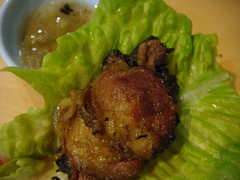
8 oz pork (any lean part), small diced
8-10 small shrimps, peeled
1 medium onion, small diced
1/4 cabbage, small diced
1/3 zucchini, small diced
1 pack saengmyon (fresh noodle)*
1/4 cup jja jang (black bean sauce), fried in oil**
2 tablespoons sugar
pinch of salt
6 tablespoons vegetable oil
2 tablespoons cornstarch + 2 tablespoons water
1/4 cup water
thin julienne of cucumber and some peas for garnish
Put a large frying pan on a high heat, add vegetable oil, and cook pork for 2-3 minutes , add onion and salt, cook for 5 minutes or until almost translucent. Cook shrimp for a minute. Add cabbage, saute for another 1 or 2 minutes, jja jang goes in, stir well to mix with vegetables.Then add water and sugar, let boil and add starch mixture, stir quickly or it will lump up.
Serve over cooked noodle or rice.
Tips!
* I recommend Korean fresh noodle from Korean market, you can find in the refrigerator section.but if you're not near Asian market, you can use regular spaghetti, pasta or any choice of your noodle. Enjoy~ ^^
**There are two kinds of jja jang. One is plain(raw) bean paste and the other is sauteed version. You can buy plain one and cook with some vegetable oil. The reason to fry the paste is that raw bean paste has slightly bitter and sour taste.
if you don't like the smell of pork, add some cheong ju(rice wine, sake) or white wine before you put vegetables in. You can add shrimp, squid, and sea cucumber etc...





